View in other NatureServe Network Field Guides
NatureServe
Montana
Utah
Wyoming
Idaho
Wisconsin
British Columbia
South Carolina
Yukon
California
New York
Clustered Lady's-slipper - Cypripedium fasciculatum
State Rank Reason (see State Rank above)
Clustered lady's-slipper is known for Montana from the northwest portion of the state, where it is documented from 10 moderate to large populations, 3 historical occurrences and many additional small occurrences. Most populations occur on National Forest lands. Potential negative impacts to the species have mainly been related to timber harvesting.
- Details on Status Ranking and Review
Population Size
Score1-2 - Small to Moderate. Population size is imprecisely known but is believed to be >2,000 individuals and <100,000 individuals.
Range Extent
Score1 - Peripheral, Disjunct or Sporadic Distribution in MT: Widespread species that is peripheral, disjunct or sporadically distributed within MT such that it occurs in <5% of the state (<7,500 sq. miles or the combined area of Beaverhead and Ravalli Counties) or is restricted to 4-5 sub-basins.
CommentPeripheral in Montana
Area of Occupancy
Score1 - Moderate: Generally occurring in 11-25 Subwatersheds (6th Code HUC’s).
Environmental Specificity
Score1 - Moderate: Species is restricted to a specific habitat that is more widely distributed or to several restricted habitats and is typically dependent upon relatively unaltered, good-quality habitat (C Values of 5-7).
Trends
Score0-2 - Stable to Moderate Declines:
CommentTrend data are largely unavailable. Habitat generally appears to be stable and it does not appear likely that severe declines have occurred, though it is possible that minor or moderate declines have occurred or may be occuring across the species' range in Montana.
Threats
Score1 - Medium: 11-30% of the populations are being negatively impacted or are likely to be impacted by one or more activities or agents, which are expected to result in decreased populations and/or habitat quality and/or quantity.
CommentLow levels of threats; Timber harvesting has the potential to negatively impact some occurrences and habitat.
Intrinsic Vulnerability
Score2 - High Vulnerability: Very specific biological attributes, unusual life history characteristics or limited reproductive potential makes the species highly susceptible to extirpation from stochastic events or other adverse impacts to its habitat and very slow to recover.
CommentSpecies is intrinsicly vulnerable as a result of unusual life history or biological attributes, which makes it vulnerable to localized extirpation.
Raw Conservation Status Score
Score
7 to 10 total points scored out of a possible 19.
General Description
Clustered Lady's-slipper is a perennial with densely hairy, solitary stems, which are 5-20 cm tall and arise from a rhizome. There is a single leaf wrapped around the base of the stem and one pair of sessile, opposite leaves located near the top of the stem; these leaves are broadly elliptic to oval-shaped and are 4-8 cm broad. The 2-4 flowers are tightly clustered at the top of the stem, and each is subtended by a green, lance-shaped bract. The 3 narrowly lance-shaped sepals are 12-25 mm long and greenish brown to purplish with purple lines or spots; the lower 2 are united nearly to the tip. The 2 upper petals are similar to the sepals in shape and color; the lower petal is pouch-shaped, shorter than the sepals, and greenish yellow with brownish-purple margins and often a purple tinge. The ovary and mature capsule are densely hairy.
Phenology
Flowering in late June-early August.
Diagnostic Characteristics
Cypripedium fasciculatum is a distinctive orchid which is easily identifiable in flower and fruit. Its leaves appear to be opposite but they are actually subopposite, joined to the stem almost but not exactly in the same spot about midway up the stem. Species in the genus LISTERA resemble this orchid but are much smaller, have prominent hairs, and flowers arranged in an elongate inflorescence.
Species Range
Montana Range
Range Descriptions
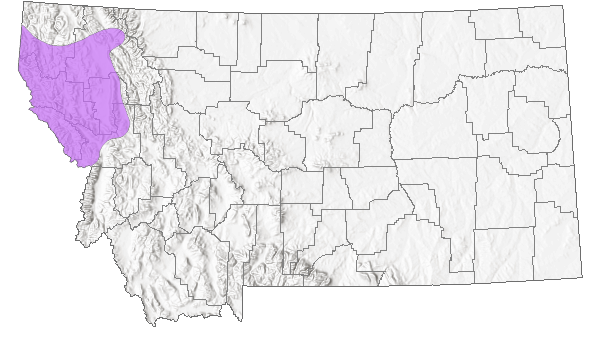
 Native
Native
Range Comments
Washington to central California, and scattered throughout the Rocky Mountains in Idaho, Montana, Wyoming, Utah, and Colorado (Camon and Arnett 1991). It is reported to occur in southern British Columbia but apparently no longer occurs there, or was incorrectly reported as having occurred there (Brownell & Catling 1987).
Observations in Montana Natural Heritage Program Database
Number of Observations: 371
(Click on the following maps and charts to see full sized version)
Map Help and Descriptions
Relative Density
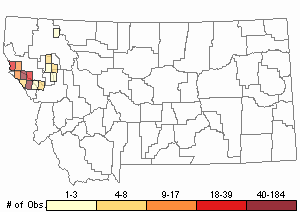
Recency
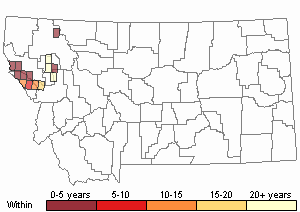

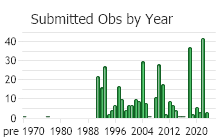
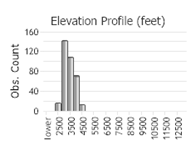 (Observations spanning multiple months or years are excluded from time charts)
(Observations spanning multiple months or years are excluded from time charts)
Habitat
Montana occurrences are mostly in warm, dry mid-seral montane forest in the Douglas fir/ninebark and grand fir/ninebark habitat types. Elsewhere in its range, it is in western redcedar habitat types.
National Vegetation Classification System Groups Associated with this Species
Forest and Woodland
Montane - Subalpine Forest and Woodland
Stewardship Responsibility
Threats or Limiting Factors
STATE THREAT SCORE REASON
Reported threats to Montana's populations of Clustered Lady’s-slipper address impacts due to wood harvesting operations and impacts due to chemical herbicide application at locations where non-native species require control (MTNHP Threat Assessment 2021). Wood harvesting operations are reported to be active at multiple populations where trampling and soil compaction following machine operations are a concern. Chemical herbicide is commonly used where non-native species are present, and where mechanical operations aim to prevent the spread of non-native plants along travel routes, and unintentional application to Clustered Lady’s-slipper plants is a risk.
References
- Literature Cited AboveLegend:
 View Online Publication
View Online Publication MTNHP Threat Assessment. 2021. State Threat Score Assignment and Assessment of Reported Threats from 2006 to 2021 for State-listed Vascular Plants. Botany Program, Montana Natural Heritage Program, Helena, Montana.
MTNHP Threat Assessment. 2021. State Threat Score Assignment and Assessment of Reported Threats from 2006 to 2021 for State-listed Vascular Plants. Botany Program, Montana Natural Heritage Program, Helena, Montana.
- Additional ReferencesLegend:
 View Online Publication
View Online Publication
Do you know of a citation we're missing? Aagaard, J.E., R.J. Harrod, and K.L. Shea. 1999. Genetic variation among populations of the rare clustered lady-slipper orchid (Cypripedium fasciculatum) from Washington state, U.S.A. Natural Areas Journal 19(3):234-238.
Aagaard, J.E., R.J. Harrod, and K.L. Shea. 1999. Genetic variation among populations of the rare clustered lady-slipper orchid (Cypripedium fasciculatum) from Washington state, U.S.A. Natural Areas Journal 19(3):234-238. Atwood, D., J. Holland, and R. Bolander [and others]. 1991. Utah - Endangered, threatened and sensitive plant field guide. Ogden, UT: U.S. Department of Agriculture, Forest Service, Intermountain Region. not paged.
Atwood, D., J. Holland, and R. Bolander [and others]. 1991. Utah - Endangered, threatened and sensitive plant field guide. Ogden, UT: U.S. Department of Agriculture, Forest Service, Intermountain Region. not paged. Brownell, Vivian R.; Catling P. M. 1987. Notes on the distribution and taxonomy of Cypripedium fasciculatum Kellogg ex Watson (Orchidaceae). Lindleyana. 2(1): 53-57.
Brownell, Vivian R.; Catling P. M. 1987. Notes on the distribution and taxonomy of Cypripedium fasciculatum Kellogg ex Watson (Orchidaceae). Lindleyana. 2(1): 53-57. Crawford, R.C. 1983. Pacific yew community ecology in north-central Idaho with implications to forest land management. Ph.D. Dissertation, University of Idaho, Moscow.
Crawford, R.C. 1983. Pacific yew community ecology in north-central Idaho with implications to forest land management. Ph.D. Dissertation, University of Idaho, Moscow. Fowlie, J. A. 1988. Cypripedium fasciculatum on serpentine landslides of northwestern California. The Orchid Digest 52(3): 137-139.
Fowlie, J. A. 1988. Cypripedium fasciculatum on serpentine landslides of northwestern California. The Orchid Digest 52(3): 137-139. Greenlee, J. 1997. Cypripedium fasciculatum conservation assessment. USDA Forest Service - Region 1, Lolo National Forest, Montana. [Unpublished report.] 23 pp.
Greenlee, J. 1997. Cypripedium fasciculatum conservation assessment. USDA Forest Service - Region 1, Lolo National Forest, Montana. [Unpublished report.] 23 pp. Kagan, J. 1990. Species management guide for Cypripedium fasciculatum for southwestern Oregon: Klamath National Forest (in Oregon), Rogue River National Forest, Siskiyou National Forest, Umpqua National Forest, and Medford District of the Bureau of Land Management. Oregon Natural Heritage Program, Portland. 19 pp. Draft.
Kagan, J. 1990. Species management guide for Cypripedium fasciculatum for southwestern Oregon: Klamath National Forest (in Oregon), Rogue River National Forest, Siskiyou National Forest, Umpqua National Forest, and Medford District of the Bureau of Land Management. Oregon Natural Heritage Program, Portland. 19 pp. Draft. Kaye, T., M. Bahm, A. Thorpe, E. Gray, I. Pfingsten, and C. Waddell. 2019. Population Extinctions Driven by Climate Change, Population Size, and Time Since Observation May Make Rare Species Databases Inaccurate. PLoS One 14(10): e0210378.
Kaye, T., M. Bahm, A. Thorpe, E. Gray, I. Pfingsten, and C. Waddell. 2019. Population Extinctions Driven by Climate Change, Population Size, and Time Since Observation May Make Rare Species Databases Inaccurate. PLoS One 14(10): e0210378. Lesica, P., M.T. Lavin, and P.F. Stickney. 2012. Manual of Montana Vascular Plants. Fort Worth, TX: BRIT Press. viii + 771 p.
Lesica, P., M.T. Lavin, and P.F. Stickney. 2012. Manual of Montana Vascular Plants. Fort Worth, TX: BRIT Press. viii + 771 p. Lesica, P., M.T. Lavin, and P.F. Stickney. 2022. Manual of Montana Vascular Plants, Second Edition. Fort Worth, TX: BRIT Press. viii + 779 p.
Lesica, P., M.T. Lavin, and P.F. Stickney. 2022. Manual of Montana Vascular Plants, Second Edition. Fort Worth, TX: BRIT Press. viii + 779 p. Lichthardt, J. 1992. Report on a sensitive plant survey of portions of the Sneaky-Sheep, Mid-Skull/Upper Bear, and Leuty timber sale areas. Idaho Department of Fish and Game, Conservation Data Center, Boise. 5 pp. plus maps.
Lichthardt, J. 1992. Report on a sensitive plant survey of portions of the Sneaky-Sheep, Mid-Skull/Upper Bear, and Leuty timber sale areas. Idaho Department of Fish and Game, Conservation Data Center, Boise. 5 pp. plus maps. Lichthardt, J. J. 1992. Community and population monitoring in Aquarius Research Natural Area, Clearwater National Forest. I. Plot establishment and baseline data, 1991. Conservation Data Center, Idaho Department of Fish and Game, Boise. 12 pp. plus appendices.
Lichthardt, J. J. 1992. Community and population monitoring in Aquarius Research Natural Area, Clearwater National Forest. I. Plot establishment and baseline data, 1991. Conservation Data Center, Idaho Department of Fish and Game, Boise. 12 pp. plus appendices. Lichthardt, J. J. 1992. Monitoring plan for US Forest Service Region 1 sensitive plants in the Steep Creek timber sale area, North Fork Ranger District, Clearwater National Forest. Idaho Department of Fish and Game, Conservation Data Center, Boise. 21 pp.
Lichthardt, J. J. 1992. Monitoring plan for US Forest Service Region 1 sensitive plants in the Steep Creek timber sale area, North Fork Ranger District, Clearwater National Forest. Idaho Department of Fish and Game, Conservation Data Center, Boise. 21 pp. Lorain (Ebrahimi), C. 1991. Rare plants on the Idaho Panhandle National Forests. Unpublished pamphlet prepared for USDA Forest Service, Idaho Panhandle National Forests, Coeur d'Alene, ID. 49 pp.
Lorain (Ebrahimi), C. 1991. Rare plants on the Idaho Panhandle National Forests. Unpublished pamphlet prepared for USDA Forest Service, Idaho Panhandle National Forests, Coeur d'Alene, ID. 49 pp. Lorain, C. C. 1991. Action plan for sensitive plant species on the Clearwater National Forest. Unpublished report. 63 pp. plus appendices.
Lorain, C. C. 1991. Action plan for sensitive plant species on the Clearwater National Forest. Unpublished report. 63 pp. plus appendices. Parker, T. 1986. Ecology of western redcedar groves. Unpublished dissertation, University of Idaho. 187 pp.
Parker, T. 1986. Ecology of western redcedar groves. Unpublished dissertation, University of Idaho. 187 pp. Porter, C. L. 1965. A flora of Wyoming. Part 4. Bulletin 434. Laramie, WY: University of Wyoming, Agricultural Experiment Station. 88 p.
Porter, C. L. 1965. A flora of Wyoming. Part 4. Bulletin 434. Laramie, WY: University of Wyoming, Agricultural Experiment Station. 88 p. Steele, R. W. 1971. Red alder habitats in Clearwater County, Idaho. Unpublished thesis, University of Idaho, Moscow. 88 pp.
Steele, R. W. 1971. Red alder habitats in Clearwater County, Idaho. Unpublished thesis, University of Idaho, Moscow. 88 pp. Watson, T. J. Jr. 1976. An evaluation of putatively threatened or endangered species from the Montana flora. Prepared for USDA Forest Service, Missoula, MT. 31 pp.
Watson, T. J. Jr. 1976. An evaluation of putatively threatened or endangered species from the Montana flora. Prepared for USDA Forest Service, Missoula, MT. 31 pp.
- Web Search Engines for Articles on "Clustered Lady's-slipper"





